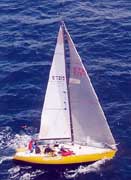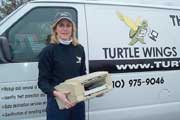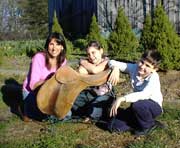|
|
 |
||||||
|
Volume 13, Issue 14 ~ April 7 - 13, 2005
|
|||||||
|
|
Feature Sories
The Sailing Life
Ultimately, he was one of 20 sailors to compete in qualifying rounds in Florida this past February. Five finalists would be sent to Portugal for more hard-sailing competition; two of the five would join the Volvo crew. Apparently Majer had the right stuff, for he graduated from the Florida competition onto Portugal. Trial by Water The trials he faced in Portugal were, in his words, "secretive. They didn't tell us, we want you to do this or that or show us how to such and such. Basically, they put us on the boats, set watch schedules and task rotations and told us to just go sail." It was strange, he said, because no one knew what the judges were looking for. "They never did say, and I still don't know any details of the criteria they were using." The watch schedules were strange, too. "They were set differently from the norm, and it made getting into a routine more difficult," he said. By the time I finally began to move smoothly through it, to get a sense of routine, it was all over." The Volvo contenders spent their first week in Portimao, Portugal, sailing morning and afternoon, between medical testing and crew meetings. The second week they spent several days sailing around the clock. That was where the strange watches and rotations came in. They completed long-distance offshore sailing trials, all on the 60-foot Pindar, famous for its solo round-the-world travels under skipper Emma Richards. These extended days of 24-hour sailing were physically taxing, Jan said. His stepped-up physical training helped him through it. At the final cut, just before Easter, Majer lost out. The young yachtsman was low-key about the results. How did he feel? "Well, not very good." That was that. A Sailor's Heading It's not as if he suddenly became a homeless wayward seaman looking to hook a job on the next outbound freighter. The fact is, Majer has been a professional sailor for more than five years, having logged more than 20,000 miles of sea travel. He is caretaker and part of the crew for the Annapolis-based racing yacht Yellowjacket. After competing in Portugal, he caught up with Yellowjacket in Florida for spring racing. After Florida, Yellowjacket races in Charleston, South Carolina, before returning to Annapolis. "We do about 20 races a year, not counting some of the smaller ones close to home," Majer said. "I want to keep going, and work to get better and better at it. Right now, that's my heading. If something else seems right in the future, then I'll reassess things." While NASCAR and other land-based racing vehicles are towed by trailer from race to race, racing yachts must sail to each race. It's easy to rack up the miles under the circumstances, and having the boats in the water and on the move requires extra maintenance. Beyond regular upkeep, racing boats must be kept in racing shape, which is more precise than for pleasure boats. The challenges and rewards all blur together for sailors like Majer. His longest single trip so far has been the trans-Atlantic passage from Newport, Rhode Island, to France. As part of this year's racing ticket, he will be aboard Yellowjacket for the Annapolis-to-Newport run in June. Making a Career of It While the sea is his first great love, she has not been all-consuming. Majer is a graduate of the Baltimore School for the Fine Arts and a classically trained trumpet player who's played at the Peabody Conservatory in Baltimore. But those loves play second fiddle. "Trumpet and racing boat just don't go together," he said. Social life off the boat includes jamming with friends who have a band in Annapolis, but he's not playing classical music in that venue. As far as careers go, he said, "there's not a lot of demand for classical trumpet players. At least now I do have sort of a half of a real job, and doing something I truly want to do." Sea lovers though Majer's parents are, they balked at his hope to make a career of racing. If the Volvo trials didn't give him a coveted berth, they did help win over his parents. "This opportunity seemed to make what I'm doing more legitimate to them," he said. If you're in Annapolis watching the boats, look for a racing yacht named Yellowjacket, and you may see a blond young man determinedly tuning rigging. Then again, if you see the boat gliding swiftly along, sails full of wind, heeling cleanly, clearing her own path amid others in a Bay race, you can bet that a quietly proud young man, recently returned from an adventure in Portugal, is aboard and focused on winning. A sailor, journalist and grandmother, Alice Snively lives with her husband aboard the 43-foot Columbia Cherokee II, berthed at the Maryland Yacht Club in Pasadena when not out sailing.
Recycling catches up with the electronic age by Carrie Steele If you're like over half of American households, there's an old computer gathering dust in your closet, attic, basement or garage. What else can you do with outdated electronics? You could sneak it into your trash can. You could try the Smithsonian to see if they're in the market for archaic computers or fax machines. But if you've tried to recycle, you've likely found that computers, cell phones and monitors are unwanted. That's why Elizabeth Wilmot, who's found herself in just such a conundrum, now does business as Turtle Wings. "Years ago, I had an old computer stashed away, and in the back of my mind, I knew I shouldn't throw it out," said Wilmot, 43, of the impetus behind her month-old recycling service. Throwing anything out went against the grain for this daughter of parents who even washed and reused aluminum foil. "Our family saved everything for some future use. We even had a special bag for pieces of string that we saved," Wilmot recalled. "I think I still see the same wrapping paper every Christmas." So the old computer not only cluttered her closet; it weighed on her conscience. "The computer was so out of date, and I wasn't going to throw it into the landfill," Wilmot continued. She was right to bypass the landfill. Computers leak their metallic contents into the ground. Eventually these stealthy poisons make their way into our water systems. Keeping computers out of landfills is why Anne Arundel County is in its third year of e-Cycling. But you'll have to wait months if you want to drop off your computer: The next county eCycling day is Saturday, November 19, at the Glen Burnie Convenience Center. Once a year is not very often. "I spent hours figuring out how to recycle it," Wilmot said. "I thought, I can't be the only person thinking how can I recycle this?" Thus was Turtle Wings born. "I wanted something green, that showed the ease of whisking a piece of electronics away," Wilmot explained about her company's name. Now, for a small price, she'll come to your door so you, too, can recycle. "It's especially important in the Chesapeake watershed area, because the lead, mercury and other contaminants seep back into the groundwater and back into the Chesapeake," explained Wilmot. Out with the Old You can't pawn off your old clunky television to Turtle Wings, because Wilmot hasn't figured out the market for TV components yet. Otherwise, Turtle Wings will haul off most metal and electronic equipment, including hard drives, monitors, printers, cell phones and more. They've even taken a gas grill, Wilmot said. Since March 1, Wilmot and her two drivers have retrieved equipment from north of Baltimore, down through Washington and northern Virginia. Dressed in Turtle Wings' navy-blue shirt and cap, Wilmot made a stop at Bay Weekly last week to haul away two old fax machines (including one that died just days earlier) three monitors and two dinosaur Macintoshes. Though Bay Weekly's equipment was fairly manageable and light, her drivers have carted off huge monster office copiers, even a mainframe, Wilmot said. Completing the Cycle Computers are actually a multi-media stew of metals, plastic, glass and more. When you trash a piece of electronic equipment, Wilmot said, "all the resources, energy and elements that have been mined or drilled go to waste." Threatening our groundwater and waterways are the collection of metals that make up computers and other electronics - including lead, mercury, cadmium and barium. "A typical desktop computer can have up to eight pounds of lead and mercury," Wilmot said. With new technologies rolling off the production line like runway fashions in New York City, computer systems, cell phones and other electronics often fall by the wayside like last season's trends. Or systems fail after years of use. Wilmot tries to get the highest or best usage out of discarded equipment. Sometimes it can be refurbished and resold, or parts can be recovered for newer machines. In its debut month, Turtle Wings has already claimed about 1,000 pieces of equipment for reincarnation and recycling. Wilmot's company serves as the missing logistic link between used equipment and new life. She partners with other businesses that help assess each piece of equipment. Baltimore-area affiliates employ 100-plus employees, many of whom have disabilities, to disassemble pieces, before they're sent back to manufacturers. Unlike county recycling programs that have specific dates and times for electronics drop-off, Wilmot's turtle-truck will come when you call to haul away prehistoric systems or machines. They'll also permanently erase all the data off your hard drive, so no one can recycle your personal or business information from a discarded computer. If you have very sensitive data, we'll not only run our program that deletes the computer's memory, we'll physically shred it for you," Wilmot said. Wilmot's own drive to recycle is fueled by her quest to live in a globally responsible way. A former vice president of marketing for Citigroup Financial Services, Wilmot broke away from the corporate life to follow her dream. "Being globally responsible means that all of our small choices affect everybody else in the rest of the world; each of us is more than just an individual here," Wilmot said. "It's not against the law to throw out a computer, but that doesn't mean that it's the right thing to do." Turtle Wings: 410-975-9046. Learn about county eCycling on www.aacounty.org or www.co.cal.md.us
Family's Roedown traditions at the Marlborough Hunt Races by Louise Vest Among the heirlooms people inherit from their parents, a parking spot is not one that immediately springs to mind. But for Marcia Handrick, her inherited tailgating spot at Roedown is a ticket to tradition. For the last 31 years, the Handrick family of Calvert County has gathered in all kinds of weather on the occasion of a horse race that's become a rite of spring. Back when Handrick's father, Bob Hammett, started the tradition, finding a parking space was no problem. "Mr. Hammett and everyone else parked up on the hill," said Ginna Gould, past race publicist. "There was only one row of cars then." The Hammett family was there from the beginning. "When the race first started it was very intimate," Handrick recalled. "It was also very generational. We had our pony show, and the kids of my parents' friends became our friends," she said. "My parents really loved their parking site. My mom liked to sit and watch all the people walk by." Grown up, Handrick reserved the space next to her parents. After their deaths, she took over their spot. These days, when 5,000 people come to Roedown Farm in Davidsonville to see the race and many set up tailgate picnics, there's much jockeying for well-placed spaces. So Marcia Handrick claims a spot with distinction. Saddle Up! It's a wonder that Bob Hammett was able to make entree into the horse world at all. Handrick's dad was born to a poor tenant farming family in Upper Marlboro during the Great Depression. When he was 17, polio settled into his jaw. Doctors gave him little hope of surviving the paralytic disease. But Hammett fought his illness, and his family prospered when his grandfather inherited the farm where the family worked. Hammett opened a sawmill on the farm, helping to pump up the family bank account. At first, he directed the workings of the sawmill from his bed. Eventually, he mastered the disease, his only apparent handicap being speech that his daughter describes as somewhat difficult to understand. The mill did so well that at age 22, Hammett bought the next-door farm. "Mr. Hammett was a good guy. I think his success came from a combination of good judgment, luck and hard work," said Gould. He rode only the work horses on the farm, but the Zantzingers, a prestigious family who lived nearby, befriended the young farmer turned entrepreneur and invited him to join the Marlborough Hunt Club, an organization founded by 12 men and women in 1936. "Most of the original members of the Marlborough Hunt Club were well-to-do descendants of those who originally settled Maryland," Gould explained. To hunt with the club, Handrick said her dad figured he'd need a good horse and a saddle. For the long-lived horse he named Mary Anne, not just any saddle would do. He chose a custom-made Smith-Worthington, a suede one at that. His was one of only two made by the company; radio and TV personality Arthur Godfrey owned the other. Today, Bob Hammett's saddle is another of Handrick's treasured hand-me-downs. Despite his good horse and fine saddle, Hammett wasn't a trained rider, but he emulated the others and didn't fall off. Hammett's wife, Ann, didn't ride much, so Handrick and her siblings were her dad's riding sidekicks. Handrick's sister, Elizabeth Smith, became a huntswoman as a teenager, the first woman to achieve that status at the Marlborough race. In 1974, the club made the spring meet a public event. In later years, Hammett became one of an ever-increasing number of spectators, but he always toured his grandchildren around the grounds and the paddock, making sure they understood all that they saw. Where's the Ice? Marcia Handrick has a prime parking site at the race, but she does not compete in tailgate contests. You'll find no themed decorations frothing from the back of her vehicle, no salmon mousse, no silver tea set nor any ice sculpture. "I have too many kids running around on race day to do that," Handrick said of her clan of five, who often have friends in tow at Roedown. While the race brings kindred spirits together mostly as spectators, Handrick's daughter Annie will soon begin horseback riding lessons. "She's been pestering for a horse, but lessons first," Handrick said. If Annie remains smitten by riding, she has a very special saddle to grown into. Riders or not, the Handrick family enjoys watching the horses race across those velvet fields in an event that's a poignant, loamy slice of childhood for Marcia, who has first-rate memories to go along with the second-hand parking spot and used saddle. "With his country background, my dad was a low-keyed man," she said. "He started with nothing and did so well. I was proud to be his daughter. He won the race." Sunday, April 10, is the date for this year's 31st Marlborough Hunt Cup at Roedown. Gates open at 10am; first race at noon. Rain or shine; no pets. See 8 Days a Week or marylandsteeplechasing.com. |
||||||
|
© COPYRIGHT 2004 by New Bay Enterprises, Inc. All rights reserved. |




